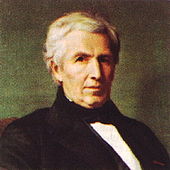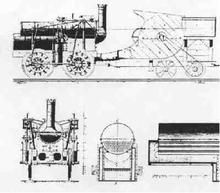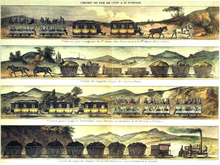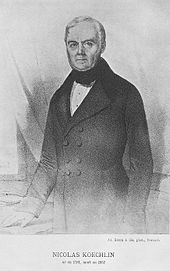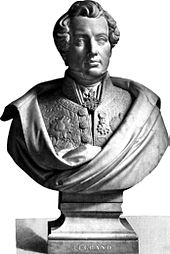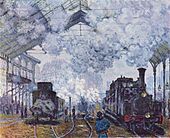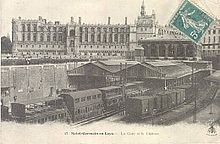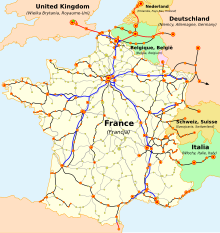History of the railroad in France
The history of the railroad in France extends from the first French railroad in 1827 to today's high-speed TGV traffic . The construction of railways in France began earlier than in the neighboring then small German states , and by 1914 the built line had a length of 40,000 kilometers. The later maximum expansion was 60,000 kilometers, for 2010 the length of the route network was given as 29,000 km.
Beginnings
In the 19th century, railway construction in France began with short mine railways . In 1814, the chief engineer of the mines Pierre Michel Moisson-Desroches (1785–1865) addressed Napoleon a memorandum on the "possibility of reducing distances by running through the empire with seven large railroad tracks". Baptiste Alexis Victor Legrand also referred to this memorandum in 1838 with his design of railway lines running in a star shape towards Paris .
Louis XVIII In 1823 issued a first concession for the initially 18 and later 21 km long horse-drawn tram between Saint-Étienne and Andrézieux to the mining engineers Louis-Antoine Beaunier and Louis de Gallois for the removal of hard coal . The line was opened on June 30, 1827.
On June 7, 1826, the concession for a railway from Saint-Étienne to Lyon (58 km) was granted to Marc Seguin . The first section of the Saint-Étienne – Lyon railway went into operation in 1830. This stretch was in competition with the Givors Canal on the Rive-de-Gier , which has been widely used since its completion in 1780. The bad management of the canal was beneficial to the competing railways. During the construction period, the first steam locomotives built by Marc Seguin in France were tested here from 1829 and used regularly in train service from 1831. It was - also from 1831 - the first route in France that was used for public travel. The locomotives supplemented the horse business. In 1832 the line was extended to Lyon and on this section it was already double-tracked. In 1832, the 67 km long Roanne – Andrézieux railway line was opened with a license dated August 27, 1828 , which was operated with two locomotives from the start.
On July 9, 1835, the brothers and bankers Isaac Pereire and Émile Pereire were granted a concession for the first railway line in France exclusively reserved for passenger transport from Gare Saint-Lazare in Paris to Saint-Germain-en-Laye (21 km) . Other bankers, including James de Rothschild , were involved. Engineer Eugène Flachat initially only built the section to Pecq . The line went into operation on August 24, 1837. The rest of the route, with a steep increase of 35 ‰, could not be mastered with the locomotives of that time. It was not until 1847 that it was possible to travel to Saint-Germain-en-Laye: until 1860, however, with an atmospheric railway .
The rail network around Saint-Étienne was expanded to include the overland tram from Montrond to Montbrison . This horse-drawn tram was in operation from 1839 to 1848.
The Paris-Versailles line (Rive droite et gauche) was built in accordance with the law of July 9, 1836 and again by Marc Seguin.
In 1837 Nicolas Koechlin founded the Compagnie du chemin de fer de Mulhouse à Thann for the construction of a railway line from Mulhouse to Thann, which was approved in 1839 and completed on September 1st. The locomotives for this line came from the factory of his cousin André Koechlin . In April 1839, the short Montpellier- Cette (now Sète ) line went into operation.
On July 15, 1840 a concession for the construction of a railway line from Rouen to Le Havre was granted; this was put into operation in sections from 1843 to 1847 and was part of the Paris – Le Havre railway line .
From August 19, 1840, the 84.5 km long railway line Alès - Nîmes - Beaucaire built by Paulin Talabot connected another coal mining area with the Rhône.
On September 20, 1840, the first section Paris Gare d'Austerlitz - Juvisy of the first French long-distance route Paris – Orléans , as well as the branch line Juvisy – Corbeil, opened. The main part of this 114 km long connection went into operation on May 2, 1843 (concession May 26, 1838).
Nicolas Koechlin also built the Strasbourg – Basel line (140 km). On October 25, 1840, the section to Saint Louis was put into operation, the one across the Swiss border to Basel on June 15, 1844. The latter was the first railway line in Switzerland. As early as November 14, 1842, France's first cross-border railway line from Valenciennes to Quiévrain in Belgium was opened, and since August 17, 1842, it had been connected to Brussels via the Ligne Dorsale . The second route across the Franco-Belgian border connected Lille and Tourcoing since July 6, 1843 .
State intervention
After the first railways were built with royal privilege, Parliament secured the sole rights to issue building permits. The French route network was mostly created through cooperation between the state and private capital, since the latter alone did not prove to be sufficient for expanding the network.
Law of 1842
In 1838 Baptiste Alexis Victor Legrand , General Director of Bridges and Roads and Mines, designed a concept for the nationwide French railway network, which was also known as the Legrand Star because of its radial orientation towards the capital. The draft became one of the foundations of the Railway Act of 1842.
The law Loi relative à l'établissement des grandes lignes de chemin de fer , passed on June 11, 1842, laid down the conditions for government-supported railroad construction in France and was thus an important milestone in development in France.
Article one of this law called for a system of railway lines
1 ° starting from Paris:
- to the Belgian border via Lille and Valenciennes;
- to England via one or more places on the English Channel coast;
- to Germany via Nancy and Strasbourg;
- to the Mediterranean via Lyon, Marseille
- to Spain through Tours, Poitiers, Angoulême, Bordeaux and Bayonne;
- to the Atlantic through Tours and Nantes;
- to the center of the country via Bourges;
2 ° (in the original without title)
- from the Mediterranean to the Rhine via Lyon, Dijon and Mulhouse;
- from the Atlantic coast to the Mediterranean via Bordeaux, Toulouse and Marseille.
In the second article, the law set out the principle for state funding for railway construction: “The municipalities transfer ownership of the land for the routes to the state, the construction of the routes by the state, which allowed the railway companies to use them, and a monopoly for operation granted, position of the railway tracks, structural facilities and rolling stock as well as operational management by the railway companies ”.
Consequences of the law of 1842
The state often accelerated the procurement of the land through expropriations and financed bridges , tunnels and routes . The Ponts et Chaussées (bridges and roads) administration helped the companies plan and build new routes. Under these circumstances, new railway companies quickly established themselves:
- on May 2, 1843 the Paris – Orleáns railway
- on July 19, 1845 a branch of the route Rouen – Havre to Dieppe and Fécamp
- by decree of December 11, 1851, the Paris (Mantes) –Caen – Cherbourg, Versailles – Rennes routes
- by decree of December 1, 1851, the Paris Belt Railway
- by decree of August 12, 1852, the Paris – Auteuil route.
- in June 1846 the Chemins de fer du Nord by the French Rothschild family
- in May 1848 the Amiens - Boulogne line .
- in March 1849 the Compiègne - Noyon railway
- in July 1849 the Chemin de fer de Paris à Strasbourg
- in August 1849 the Tours - Angers railway
- in April 1851 the railway to Argenteuil .
The original law of 1842 licensed the routes for 36 years. In response to the demand for longer-term concessions, Napoléon III. after he came to power, the period extended to 99 years.
However, the most successful companies, especially the Compagnie du Nord, built their routes on their own to avoid the complications of government involvement.
During the economic boom in the 1850s, the state only paid 19% of the construction costs. The forms of subsidization were varied: money in the form of cash grants or land (up to 1884 in a total amount of more than 1½ billion francs ), interest guarantee grants (as a result of the law of June 11, 1859), which include grants for the Algerian railways reached the total amount of 700 million francs by 1883, favored mergers , long concessions and mild application of the state supervision right. In return for assuming part of the construction costs, the government set price caps for the companies. The state also decreed that all state transports were billed at a third of the standard tariffs.
The expectation that the government would later nationalize the railway system was another important element in French railway legislation. The fact that the railway companies only worked on leased state lines paved the way for the nationalization of the French railways under the Popular Front government in the 1930s.
Expansion of the railway star
- Listed geographically clockwise as well as from Paris to the periphery -
- Paris– Le Havre , branching off from the Paris – Saint-Germain line:
- Paris – Lille , opened June 20, 1846, creating the second continuous rail connection from Paris to Belgium via the route from Lille to Tourcoing, which was opened on July 6, 1843 .
-
Douai - Valenciennes - Quiévrain (Belgium, Ligne Dorsale to Mons ), since June 14th 1846 first rail connection from Paris to Brussels :
- Sin junction (Paris – Lille route) –Valenciennes opened on June 14, 1846
- Valenciennes – Quiévrain opened on November 14, 1842
October 15 1843, the distance over had Aachen to Cologne the Rheinische Eisenbahn-Gesellschaft connected to the Belgian grid. The union of the Western European and Central European networks was not achieved until October 3, 1859, via the Cologne Cathedral Bridge .
- Creil – Jeumont, branches off in Creil from Paris – Lille
- Creil – Compiègne, opened October 21, 1847
- in several stages to Saint-Quentin October 21, 1847
- until Jeumont 1855
- Paris – Nancy – Strasbourg , opened 1849–1852
- Paris – Troyes – Mulhouse (Mulhouse),
-
Paris – Dijon – Lyon
- Paris– Tonnerre , opened August 12, 1849 ( Melun - Montereau as early as January 31, 1849)
- Tonnerre– Dijon , opened June 22, 1851
- Dijon– Chalon-sur-Saône , opened September 2, 1851
- Chalon-sur-Saône-Lyon Vaise, opened October 7, 1854
- Lyon Vaise – Lyon Guillotière, only opened on October 7, 1856.
- Lyon – Marseille was built from Marseille:
- Paris – Orléans , opened September 20, 1840
- Orleáns - Châteauroux - Saincaize (near Nevers ), opened November 15, 1847 to Châteauroux, October 5, 1850 to Saincaize
- Saincaize– Nevers , opened October 5, 1850
- Saincaize – Moulins– Clermont-Ferrand , opened May 15, 1853 to Moulins-sur-Allier , May 7, 1855 to Clermont-Ferrand
- Orléans – Tours – Bordeaux :
- Tours– Nantes , opened between 1848 and August 21, 1851 (concession 1845)
Mergers to form the "large societies"

Mergers took place soon after the first railways were established.
In 1852 the Paris – Orléans, Center, Orléans – Bordeaux and Tours – Nantes railways merged to form the Compagnie du chemin de fer de Paris à Orléans . The "Compagnie du chemin de fer de Paris à Strasbourg", founded in 1845, merged in 1853 with the "Compagnie du chemin de fer de Montereau à Troyes" to form the Compagnie des chemins de fer de l'Est .
The Compagnie des chemins de fer du Midi was founded in 1853 by taking over concessions for the Bordeaux - Cette ( Sète ), Narbonne - Perpignan and Lamothe - Bayonne lines . In 1858 the Bayonne - Irun and Adge - Lodève lines were added to the CF du Midi. The Compagnie des chemins de fer de l'Ouest was created on April 7, 1855 through the merger of the Paris- Versailles - Saint-Germain-en-Laye , Paris- Rouen , Rouen- Le Havre , Paris- Rennes and Paris- Caen - Cherbourg railways .
From 1843 to 1856, several railway lines between Paris and Lyon and between Paris and Marseille were built and operated. These individual companies merged into two larger companies, namely the Compagnie du chemin de fer de Lyon à la Méditerranée (LM) and the Compagnie du chemin de fer de Paris à Lyon (PL). On April 11, 1857, the PL and LM were dissolved again and merged to form the Compagnie des chemins de fer de Paris à Lyon et à la Méditerranée (PLM), which until 1934 was the largest private railway in France.
In 1878, the French government took over ten railway companies, which were not operating very profitably and were therefore threatened with recruitment, to the newly founded state railway Chemins de fer de l'État . By the law of December 18, 1908, the Chemins de fer de l'Ouest was taken over by the Chemins de fer de l'État on January 1, 1909 .
In 1934 the "CF du Midi" merged with the "Paris - Orléans" to form the Chemin de Fer de Paris à Orléans et du Midi (PO-Midi) and with this formed the largest private railway in France until it was taken over by the state railway SNCF (1938) .
Railway belt around Paris
In the middle of the 19th century, the first private railroad companies in France built star-shaped railroad lines from different parts of the country, each with its own terminus . Goods that had to be transported from one part of the country to the other with the long detour via Paris because of this network structure had to be reloaded in Paris on horse-drawn vehicles, transported to the stations of the continuing lines and reloaded there. Travelers had to take the same detours. This gave rise to the desire for a railway belt ( Chemin de Fer de Ceinture ) or a bypass around Paris.
Under the leadership of the Minister for Public Works, Pierre Magne, on December 10, 1851, the railway station operating companies signed the concession agreement for the link on the right bank of the Seine (French: Rive droite ) and for the Syndicat de Chemin de Fer de Ceinture joint venture each contributing a million francs to the joint venture. The contribution of the bankrupt Compagnie du chemin de fer de Paris à Orléans was taken over by the French state. In return, the state promised to finance the construction of the route. The link on the left bank of the Seine (French: Rive gauche ) was completed on February 27, 1867.
The conditions also included the establishment and operation of passenger transport . However, the operating companies were primarily interested in the more lucrative freight traffic , and passenger traffic was only started on the entire ring from July 14, 1862.
The first, “small”, belt was supplemented from 1877 by a “large” belt (Grande Ceinture) with the first section opened in 1877 between Noisy-le-Sec northeast of Paris and Villeneuve-Saint-Georges . The other routes built up to 1886 touch, viewed clockwise on the map, from Villeneuve-Saint-Georges the places Rungis (north of today 's Orly airport , with a later parallel route south of Orly via Juvisy-sur-Orge ), Massy , Palaiseau , Versailles , Saint-Germain-en-Laye , Achères , Sartrouville and again Noisy-le-Sec. The Great Belt is about 120 km long.
Expansion of the route network
In 1879, the then Minister for Public Works Charles de Freycinet presented a plan according to which all French people should have access to the railroad or any town with more than 1,500 inhabitants a standard-gauge connection, with gaps being closed by narrow-gauge lines to support economic development and developing less developed areas. On July 17, 1879, the “Freycinet Plan” became law and resulted in the state buying up and building new railways and canals on a large scale or subsidizing their construction by the large companies.
With regard to the latter, an agreement with the PLM , the PO , the Midi , the Nord , the Est and the Ouest was agreed with the law of November 20, 1883 , according to which they took over the concessions for some lines to be opened and operated them for a fixed amount. The state undertook to subsidize the costs in excess of this amount.
The network grew from 29,600 kilometers to the final execution of the plan in 1914 with 180 new routes to 39,400 kilometers including 2500 km of newly built branch lines . This meant that all sub-prefectures and all important cities in France were connected to the railroad, even if in many cases only with narrow-gauge railway lines of low loading capacity. Overall, around a third of the network consisted of narrow-gauge lines.
Introduction of electric traction
- Electric rail operation took place for the first time in 1893 on a 2.8 km long railway line from the Mont-Rambert coal mine to Saint-Étienne .
- Another electrically operated mine railway was set up in the Godbrange iron ore mine in Lorraine from 1897 . The historical picture shows a two-axle narrow-gauge locomotive and power rails attached in pairs overhead . The operating voltage was 500 volts, the track width 740 millimeters.
- In 1900, the Compagnie du chemin de fer de Paris à Orléans (PO) and the (Ouest-Etat) put on a rail network with 550 volts direct voltage supply over a conductor rail through the suburbs of Paris.
- In 1908 the Compagnie du Midi electrified its lines in the Pyrenees with alternating current of 12 kV and 16 2/3 Hz.
- In 1920 the government decided, in order to avoid “ balkanisation ” of the network, to prefer a supply with direct voltage of 1500 V for all new line electrification .
- As a result, the direct current system established itself in France in the southern regions, but from the middle of the 20th century the 25,000 volt 50 Hertz single-phase alternating current system in the north, which was later introduced on all TGV high-speed routes.
Almost exactly half of the approximately 29,350 kilometers of standard-gauge railway lines in France (14,480 kilometers) were electrified in 2007.
Railways in Alsace-Lorraine
The Alsace-Lorraine railway network had a particularly eventful history. Large parts of the local railway network belonged to the private French Compagnie des chemins de fer de l'Est . After the Franco-Prussian War in 1870/71, Alsace and part of Lorraine were annexed to the newly founded German Empire with the Peace of Frankfurt . The approximately 800 kilometers of railway lines in Alsace were formally bought by the French state and then sold to the German Empire. These became the " Reichseisenbahnen in Alsace-Lorraine ", the first railroad owned by the German Empire.
Since the French troops the whole in retreat almost rolling stock had taken that were vehicles of the reorganized "Kingdom railway" made first by confiscated material from other German railways, the operating principle according to the regulations of the Prussian state railways performed. In the years that followed, an extensive expansion took place, after which in 1912 the route network comprised 2,100 kilometers, 78 km of which were narrow-gauge railways .
After the First World War , Alsace became French again in November 1918 or in the Versailles Treaty and the railway network was run as an independent part of the French network under the name Réseau ferroviaire d'Alsace-Lorraine (AL).
On January 1, 1938, the AL and all other French railway companies were merged to form the SNCF . From June 19, 1940, the Wehrmacht reoccupied Alsace and Alsace-Lorraine was in fact incorporated into the Greater German Reich , the railway is now administered by the Deutsche Reichsbahn .
Since the liberation in 1944/1945, the network has been in French hands again under the direction of the SNCF. As a special feature from earlier times, right -hand traffic was retained on multi-track lines ; in the rest of France left-hand traffic is common.
Nationalization and Liberalization in the EU

In the 1930s, increasing competition on the street began to take its toll. The narrow-gauge railways suffered the most, and so thousands of kilometers of narrow-gauge railway lines were shut down in the 1930s.
The larger railway companies also faced financial problems. The socialist government of France passed a law on the nationalization of the networks on August 31, 1937, according to which on January 1, 1938 the concessions and the assets of the private railway companies were transferred to the newly founded SNCF . The SNCF has the statute of a society in which the state has a majority. Pierre Guinand became the first president of the SNCF.
From 1969 onwards, there was a second large wave of railway line closures, with the branch line network in particular shrinking significantly.
In France, the first and the second European railway package were transposed into national law. Directive 2001/12 / EC, which requires the infrastructure operator to be independent of the transport service, was formally complied with by establishing the independent network company Réseau ferré de France (RFF). However, the RFF assigns essential infrastructure management tasks to the SNCF, which is practically again the network operator.
The railway system's debt burden in 2012 was EUR 38.3 million. In 2014 the government decided to bring RFF and SNCF back into a joint group. Since January 1, 2015, the parent company SNCF has consisted of the railway infrastructure company SNCF Réseau and the railway company SNCF Mobilités .
In France, despite the liberalization efforts within the European Union, almost all passenger traffic and a large part of freight traffic is handled by the state railway SNCF. The only railway companies that operate passenger rail services in France and are operated directly by SNCF are:
- Eurostar : high-speed service from Paris to London, SNCF share of 40%
- Thalys : high-speed services from Paris to Brussels , Amsterdam and Cologne , SNCF share 70%
- Alleo : high-speed traffic from Paris to Frankfurt am Main, Stuttgart and Munich, SNCF share 50%
- Thello : Night trains from Paris to Venice and from Marseille to Milan
TGV network
From 1981, the main French cities were connected by separate high-speed lines ( Ligne à Grande Vitesse ) (LGV), which are reserved exclusively for passenger traffic with the high-speed train TGV . When setting up this network, the SNCF repeated the star-shaped structure tailored to Paris. A special feature is the LGV Rhin-Rhône , which went into operation in 2011 , and is the first not to be geared towards Paris.
On September 22, 1981, the first section of the high-speed line Paris - Lyon between Saint-Florentin and Sathonay- Rillieux was opened. With the introduction of the TGV between Paris and Lyon and the increase in the maximum speed to 260 km / h, the travel time could be reduced to 2 hours 40 minutes. Today (as of January 2013) the travel time is 2 hours at a top speed of 300 km / h.
In 1994 the Eurotunnel was opened, which connects France and Great Britain by rail.
See also
literature
- Robert Beck: The Freycinet Plan and the Provinces. Aspects d. infrastructural development d. french Provinces by d. Third Republic. Frankfurt am Main / Berlin 1986, ISBN 3-8204-9791-9 .
- François Caron: Histoire des Chemins de Fer en France. Fayard, Paris 1997.
- Bruno Carrière: La Saga de la Petite Ceinture. La Vie du Rail 1991-2001, ISBN 2-902808-01-1 .
- JH Clapham: The Economic Development of France and Germany, 1815-1914. University Press, Cambridge 1961.
- Kimon A. Doukas: The French Railroads and the State. Columbia University Press, New York 1945.
- Arthur Dunham: How the First French Railways Were Planned. In: Journal of Economic History. Vol. 1, No. 1. (1941), pp. 12-25.
- The railways in France . In: Illustrirte Zeitung . No. 4 . J. J. Weber, Leipzig July 22, 1843, p. 51-52 ( Wikisource ).
- Histoire du réseau ferroviaire français. Éditions de l'Ormet / Imprimerie Bayeusienne Graphique, 1996, ISBN 2-906575-22-4 .
- Eduard Hochstrasser: Le Plan Freycinet: On the history and development of the French railways in the second half of the 19th century. (Phil. Diss.), 1977.
- Kyllmann: Statistics of the French railways. In: Wochenblatt. Vol. I, No. 51, 1867, pp. 493–494 ( PDF file; 2.2 MB )
- Allan Mitchell : The Great Train Race: Railways and the Franco-German Rivalry, 1815-1914. Berghahn Books, New York 2000.
- Simon Sterne: Some Curious Phases of the Railway Question in Europe. In: The Quarterly Journal of Economics. Vol. 1, No. 4. (1887), pp. 453-468.
Web links
- French railways. In: Viktor von Röll (ed.): Encyclopedia of the Railway System . 2nd Edition. Volume 5: Driver's Freight Tariffs . Urban & Schwarzenberg, Berlin / Vienna 1914, p. 167 ff.
- French railway wiki trains.wikia
- Profs d'Histoire Lycée Claude Lebois: histoire des chemins de fer en France , with maps of the development of the network
- Treatise on the railways to / from Lyon, particularly the Paris-Lyon-Marseille route, with numerous pictures (French)
Footnotes
- ↑ Title of the memorandum: Sur la possibilité d'abréger les distances en sillonnant l'empire de sept grandes voies ferrées .
- ^ "La Route du Charbon" in the Vallée du Gier
- ↑ Collection complète des lois, décrets d'intérét général, Volume 37 ( année 1837 ), p. 153
- ↑ a b Law of 1842 in Wikisource (fr.)
- ↑ Directive 2001/12 / EC (PDF)
- ^ Christian Kirchner, IBM Global Business Services: Rail Liberalization Index in Europe 2007. ( Page no longer available , search in web archives ) Info: The link was automatically marked as defective. Please check the link according to the instructions and then remove this notice. (PDF; 3.3 MB) p. 129, “France”.
- ↑ Pour récupérer RFF et la maîtrise du réseau Ferré, la SNCF veut faire payer passagers et contribuables . In: Challenges . ( challenges.fr [accessed on March 3, 2018]).

